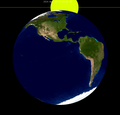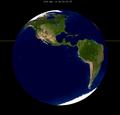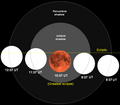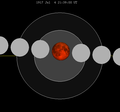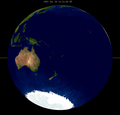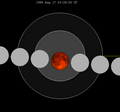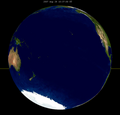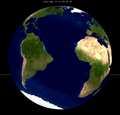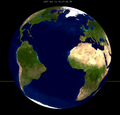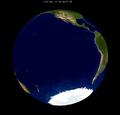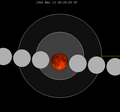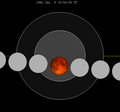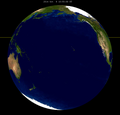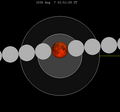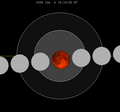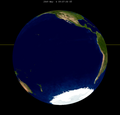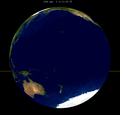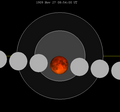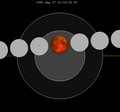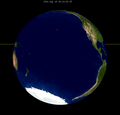Top Qs
Timeline
Chat
Perspective
September 2025 lunar eclipse
Total lunar eclipse From Wikipedia, the free encyclopedia
Remove ads
A total lunar eclipse occurred at the Moon's ascending node of orbit on Sunday, September 7, 2025,[1] with an umbral magnitude of 1.3638. A lunar eclipse occurs when the Moon moves into the Earth's shadow, causing the Moon to be darkened. A total lunar eclipse occurs when the Moon's near side entirely passes into the Earth's umbral shadow. Unlike a solar eclipse, which can only be viewed from a relatively small area of the world, a lunar eclipse may be viewed from anywhere on the night side of Earth. A total lunar eclipse can last up to nearly two hours, while a total solar eclipse lasts only a few minutes at any given place, because the Moon's shadow is smaller. Occurring about 2.6 days before perigee (on Wednesday, September 10, 2025, at 8:10 UTC), the Moon's apparent diameter was larger.[2]
This lunar eclipse was the second of an almost tetrad, with the others being on March 14, 2025 (total); March 3, 2026 (total); and August 28, 2026 (partial).
Remove ads
Visibility
The eclipse was completely visible over east Africa, Asia, and central and west Australia. It was seen when rising over most of Africa and Europe, and when setting over the central Pacific Ocean.[3]
  |
 Visibility map |
Gallery
- All phases taken in Tuyen Quang, Vietnam, 18:23-20:02 UTC
- Total Lunar Eclipse, Ukraine 18:30 UTC
- The partially eclipsed moon rises over a mountain ridge in Trentino, Italy, 19:11 UTC
- Partial eclipse in Hefei, China, 16:37 UTC
- Partial eclipse in Surabaya, Indonesia, 16:53 UTC
- Partial eclipse in Moscow, Russia, 16:58 UTC
- Total eclipse in Surabaya, Indonesia, 17.31 UTC
- Beginning of the total eclipse in Bekasi, Indonesia, 17:32 UTC
- Total eclipse in Melbourne, Australia, 17:49 UTC
- Total Lunar eclipse in Kerala, India, 17:11:47 UTC
- Totality in Bantul, Indonesia, 18:11 UTC
- Totality in Sumedang, Indonesia, 18:17 UTC
- Total eclipse at moon rise in Berlin, Germany, 18:20 UTC
- Partial eclipse in Tel Aviv, Israel, 18:32 UTC
- Total eclipse in Blitar, Indonesia, 18:33 UTC
- Total eclipse in Surabaya, Indonesia, 18:38 UTC
- Total eclipse in Tehran, Iran, 18:38 UTC
- Ending of total eclipse in Moscow, Russia, 18:45 UTC
- Total eclipse in Berlin, Germany, 18:46 UTC
- Shortly after the conclusion of totality in Sydney, Australia, 18:54 UTC
- Ending of total eclipse in Serang, Indonesia, 19:08 UTC
- Partial eclipse behind a thin cloud in Brastad, Sweden, 19.14 UTC
- Partial eclipse in Casier, Italy, 19.35 UTC
- High dynamic range composition of end of the partial eclipse in Berlin, Germany, 19:39 UTC
- Ending of partial eclipse in Logroño, Spain, 20.06 UTC
- Lunar eclipse in Chiang Rai, Thailand, 00:37 UTC+7
- the ending of the partial lunar eclipse in Chiang Rai, Thailand, 02:23 UTC+7
- Timelapse video from Petrozavodsk, Russia
- Totality from Cebu, Philippines
Remove ads
Eclipse details
Shown below is a table displaying details about this particular lunar eclipse. It describes various parameters pertaining to this eclipse.[4]
Eclipse season
This eclipse is part of an eclipse season, a period, roughly every six months, when eclipses occur. Only two (or occasionally three) eclipse seasons occur each year, and each season lasts about 35 days and repeats just short of six months (173 days) later; thus two full eclipse seasons always occur each year. Either two or three eclipses happen each eclipse season. In the sequence below, each eclipse is separated by a fortnight.[citation needed]
Remove ads
Related eclipses
Summarize
Perspective
Eclipses in 2025
- A total lunar eclipse on March 14.
- A partial solar eclipse on March 29.
- A total lunar eclipse on September 7.
- A partial solar eclipse on September 21.
Metonic
- Preceded by: Lunar eclipse of November 19, 2021
- Followed by: Lunar eclipse of June 26, 2029
Tzolkinex
- Preceded by: Lunar eclipse of July 27, 2018
- Followed by: Lunar eclipse of October 18, 2032
Half-Saros
- Preceded by: Solar eclipse of September 1, 2016
- Followed by: Solar eclipse of September 12, 2034
Tritos
- Preceded by: Lunar eclipse of October 8, 2014
- Followed by: Lunar eclipse of August 7, 2036
Lunar Saros 128
- Preceded by: Lunar eclipse of August 28, 2007
- Followed by: Lunar eclipse of September 19, 2043
Inex
- Preceded by: Lunar eclipse of September 27, 1996
- Followed by: Lunar eclipse of August 18, 2054
Triad
- Preceded by: Lunar eclipse of November 7, 1938
- Followed by: Lunar eclipse of July 9, 2112
Lunar eclipses of 2024–2027
This eclipse is a member of a semester series. An eclipse in a semester series of lunar eclipses repeats approximately every 177 days and 4 hours (a semester) at alternating nodes of the Moon's orbit.[5]
The penumbral lunar eclipse on July 18, 2027 occurs in the next lunar year eclipse set.
Metonic series
The Metonic cycle repeats nearly exactly every 19 years and represents a Saros cycle plus one lunar year. Because it occurs on the same calendar date, the Earth's shadow will in nearly the same location relative to the background stars.
|
|
 |
Saros 128
This eclipse is a part of Saros series 128, repeating every 18 years, 11 days, and containing 71 events. The series started with a penumbral lunar eclipse on June 18, 1304. It contains partial eclipses from September 2, 1430 through May 11, 1827; total eclipses from May 21, 1845 through October 21, 2097; and a second set of partial eclipses from November 2, 2115 through May 17, 2440. The series ends at member 71 as a penumbral eclipse on August 2, 2566.
The longest duration of totality was produced by member 37 at 100 minutes, 43 seconds on July 26, 1953. All eclipses in this series occur at the Moon’s ascending node of orbit.[6]
Eclipses are tabulated in three columns; every third eclipse in the same column is one exeligmos apart, so they all cast shadows over approximately the same parts of the Earth.
Tritos series
This eclipse is a part of a tritos cycle, repeating at alternating nodes every 135 synodic months (≈ 3986.63 days, or 11 years minus 1 month). Their appearance and longitude are irregular due to a lack of synchronization with the anomalistic month (period of perigee), but groupings of 3 tritos cycles (≈ 33 years minus 3 months) come close (≈ 434.044 anomalistic months), so eclipses are similar in these groupings.
Inex series
This eclipse is a part of the long period inex cycle, repeating at alternating nodes, every 358 synodic months (≈ 10,571.95 days, or 29 years minus 20 days). Their appearance and longitude are irregular due to a lack of synchronization with the anomalistic month (period of perigee). However, groupings of 3 inex cycles (≈ 87 years minus 2 months) comes close (≈ 1,151.02 anomalistic months), so eclipses are similar in these groupings.
Half-Saros cycle
A lunar eclipse will be preceded and followed by solar eclipses by 9 years and 5.5 days (a half saros).[8] This lunar eclipse is related to two annular solar eclipses of Solar Saros 135.
| September 1, 2016 | September 12, 2034 |
|---|---|
 |
 |
Remove ads
See also
Notes
External links
Wikiwand - on
Seamless Wikipedia browsing. On steroids.
Remove ads

































